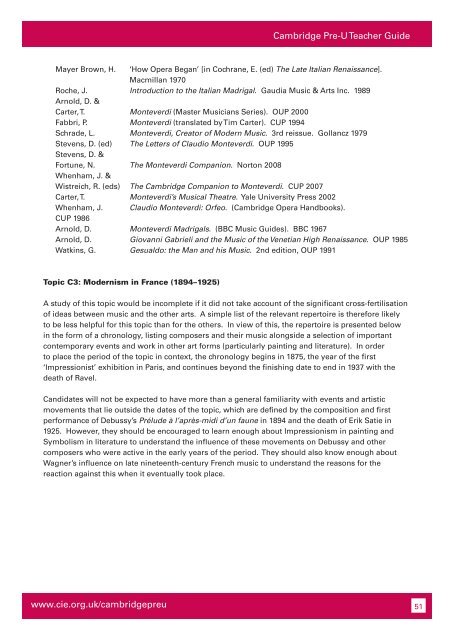Teacher's Guide Cambridge Pre-U MUSIC Available for teaching ...
Teacher's Guide Cambridge Pre-U MUSIC Available for teaching ...
Teacher's Guide Cambridge Pre-U MUSIC Available for teaching ...
You also want an ePaper? Increase the reach of your titles
YUMPU automatically turns print PDFs into web optimized ePapers that Google loves.
<strong>Cambridge</strong> <strong>Pre</strong>-U Teacher <strong>Guide</strong><br />
Mayer Brown, H. ‘How Opera Began’ [in Cochrane, E. (ed) The Late Italian Renaissance].<br />
Macmillan 1970<br />
Roche, J. Introduction to the Italian Madrigal. Gaudia Music & Arts Inc. 1989<br />
Arnold, D. &<br />
Carter, T. Monteverdi (Master Musicians Series). OUP 2000<br />
Fabbri, P. Monteverdi (translated by Tim Carter). CUP 1994<br />
Schrade, L. Monteverdi, Creator of Modern Music. 3rd reissue. Gollancz 1979<br />
Stevens, D. (ed) The Letters of Claudio Monteverdi. OUP 1995<br />
Stevens, D. &<br />
Fortune, N. The Monteverdi Companion. Norton 2008<br />
Whenham, J. &<br />
Wistreich, R. (eds) The <strong>Cambridge</strong> Companion to Monteverdi. CUP 2007<br />
Carter, T. Monteverdi’s Musical Theatre. Yale University <strong>Pre</strong>ss 2002<br />
Whenham, J. Claudio Monteverdi: Orfeo. (<strong>Cambridge</strong> Opera Handbooks).<br />
CUP 1986<br />
Arnold, D. Monteverdi Madrigals. (BBC Music <strong>Guide</strong>s). BBC 1967<br />
Arnold, D. Giovanni Gabrieli and the Music of the Venetian High Renaissance. OUP 1985<br />
Watkins, G. Gesualdo: the Man and his Music. 2nd edition, OUP 1991<br />
Topic C3: Modernism in France (1894–1925)<br />
A study of this topic would be incomplete if it did not take account of the significant cross-fertilisation<br />
of ideas between music and the other arts. A simple list of the relevant repertoire is there<strong>for</strong>e likely<br />
to be less helpful <strong>for</strong> this topic than <strong>for</strong> the others. In view of this, the repertoire is presented below<br />
in the <strong>for</strong>m of a chronology, listing composers and their music alongside a selection of important<br />
contemporary events and work in other art <strong>for</strong>ms (particularly painting and literature). In order<br />
to place the period of the topic in context, the chronology begins in 1875, the year of the first<br />
‘Impressionist’ exhibition in Paris, and continues beyond the finishing date to end in 1937 with the<br />
death of Ravel.<br />
Candidates will not be expected to have more than a general familiarity with events and artistic<br />
movements that lie outside the dates of the topic, which are defined by the composition and first<br />
per<strong>for</strong>mance of Debussy’s Prélude à l’après-midi d’un faune in 1894 and the death of Erik Satie in<br />
1925. However, they should be encouraged to learn enough about Impressionism in painting and<br />
Symbolism in literature to understand the influence of these movements on Debussy and other<br />
composers who were active in the early years of the period. They should also know enough about<br />
Wagner’s influence on late nineteenth-century French music to understand the reasons <strong>for</strong> the<br />
reaction against this when it eventually took place.<br />
www.cie.org.uk/cambridgepreu 51
















